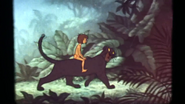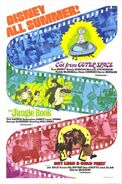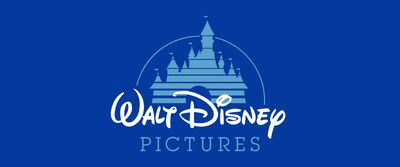No edit summary Tags: Visual edit apiedit |
No edit summary Tags: Visual edit apiedit |
||
| Line 21: | Line 21: | ||
After the film's success, Disney released [[Rudyard Kipling's The Jungle Book|a live-action remake]], and [[The Jungle Book 2|a theatrical sequel]]. |
After the film's success, Disney released [[Rudyard Kipling's The Jungle Book|a live-action remake]], and [[The Jungle Book 2|a theatrical sequel]]. |
||
| − | The film stands as one of the most popular Disney movie of all time. In it's initial release, the popularity was equivocal to that of ''[[The Lion King]]'' or ''[[Frozen]]'', making it a great influence for some of today's biggest names in animation. However, Disney |
+ | The film stands as one of the most popular Disney movie of all time. In it's initial release, the popularity was equivocal to that of ''[[The Lion King]]'' or ''[[Frozen]]'', making it a great influence for some of today's biggest names in animation. However, Disney wouldn't receive a similar success until [[The Little Mermaid]] in 1989. |
==Plot== |
==Plot== |
||
Revision as of 09:56, 23 February 2015
The Jungle Book is a American animated film produced by Walt Disney Productions and released on October 18, 1967. The 19th animated feature in the Disney Animated Canon , the film is noted for being along with The Aristocats (1970) the last film project to be approved by Walt Disney himself, as he died in late 1966, before the film was released. This is also the first animated feature released after Walt Disney's death The film was inspired by the stories about the feral child Mowgli from the book of the same name by Rudyard Kipling.
The film contains a number of classic songs, including "The Bare Necessities" and "I Wanna Be Like You". Most of the songs were written by Richard M. Sherman and Robert B. Sherman. The film was directed by Wolfgang Reitherman. The film grossed over $73 million in the United States in its first release, and as much again from three re-releases.
After the film's success, Disney released a live-action remake, and a theatrical sequel.
The film stands as one of the most popular Disney movie of all time. In it's initial release, the popularity was equivocal to that of The Lion King or Frozen, making it a great influence for some of today's biggest names in animation. However, Disney wouldn't receive a similar success until The Little Mermaid in 1989.
Plot
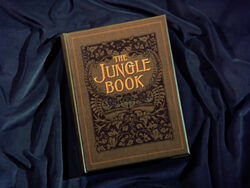
Title Card for The Jungle Book
Mowgli (Bruce Reitherman) is found in a basket as a baby in the deep jungles of Madhya Pradesh, India by Bagheera (Sebastian Cabot), the black panther. He promptly takes him to an Indian Wolf who has just had cubs. She raises him along with her own cubs and Mowgli soon becomes well acquainted with jungle life. Ten years later, Mowgli visits the wolves and gets his face licked eagerly when he arrives. One night, when the wolf pack learns that Shere Khan (George Sanders), a man-eating Bengal tiger, has returned to the jungle, they realize that Mowgli must be taken to the "man village" to protect him and those around him. Bagheera volunteers to escort him back.
They leave that very night, but Mowgli is determined to stay in the jungle. They spend the night on a large tree, where they encounter Kaa, a python who hypnotizes Mowgli and tries to eat him. Bagheera stops him, and he and Mowgli go to sleep.
The next morning, Mowgli tries to join the Indian elephant patrol led by Colonel Hathi (J. Pat O'Malley). Bagheera finds Mowgli and they argue; Mowgli runs away from Bagheera. The boy soon meets up with the fun-loving bear Baloo (Phil Harris), who shows Mowgli the fun of having a care-free life and promises not to take him to the man village.
Mowgli now wants to stay in the jungle more than ever. Before long, Mowgli is caught by a gang of monkeys and taken to their leader, King Louie (Louis Prima) the orangutan, who makes a deal with Mowgli that if he tells him the secret of making fire like a human, then he will make it so he can stay in the jungle ("I Wanna Be Like You"). However, since he was not raised by humans, Mowgli doesn't know how to make fire. Bagheera and Baloo arrive at the palace, unseen and try to plan a away to rescue Mowgli, but the catchy beat of the song distracts Baloo and he wanders off dancing. Soon, however, he appears dressed in banana skins and coconut shells posing as a female organgutan which fools the King. But soon, Baloo's disguise is revealed and there begins a mad chase between the monkeys and Baloo and Bagheera over Mowgli. The King accidentally knocks down a pillar and holds up the temple the best he can until he struggles when Baloo begins to tickle him frantically under the arms. The monkeys manage to stop Baloo's tickling, but end up bouncing the king onto the other pillar instead, causing the temple to collapse in rumble. Mowgli is rescued from King Louie by Bagheera and Baloo. Bagheera explains to Baloo that the jungle isn't safe when Shere Khan is here. In Morning, Baloo explains to Mowgli that the Man Village is best for a boy, Mowgli accuses him for breaking his promise and runs away in the deepest part of the jungle. Bagheera (after Baloo explains to him) then finds the Elephant Patrol and tells Hathi of Mowgli running away with Shere Khan himself overhearing, Hathi then organizes a special search mission for all his herd. Later, Kaa hypnotizes Mowgli into a deep and peaceful sleep, and tries to eat him (after tricking him that Mowgli can trust him), but thanks to the intervention of Shere Khan, Mowgli escapes.
He encounters a group of solemn vultures (J. Pat O'Malley, Digby Wolfe, Lord Tim Hudson and Chad Stuart), who closely resemble The Beatles, and they say they'll be his friend. The vultures argue and continually sidetrack Mowgli with their pointless arguments. Shere Khan appears shortly after and challenges Mowgli to a fight, but Baloo and Bagheera rush to the rescue. Baloo is knocked unconscious and Mowgli ties a flaming branch onto Shere Khan's tail in order to get rid of the ruthless tiger. Baloo then wakes up and he and Bagheera take Mowgli to the edge of a man-village, but Mowgli is still hesitant to go in. His mind soon changes when a young girl from the village comes down by the riverside to fetch water. After noticing the boy, she "accidentally" drops her water pot, and Mowgli retrieves it for her and follows her into the man village. After Mowgli chooses to stay in the man village, Baloo and Bagheera decide to head home.
Cast
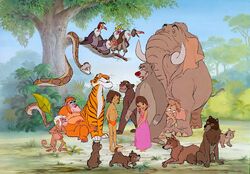
- Bruce Reitherman provided the voice of Mowgli, who is the main protagonist of the film. Mowgli is an orphaned boy, commonly referred to as "man-cub" by the other characters.
- Phil Harris voiced Baloo, a sloth bear who leads a carefree life and believes in letting the good things in life come by themselves.
- Sebastian Cabot voiced Bagheera, a serious black panther (melanistic leopard) who is determined to take Mowgli back to the village and disapproves of Baloo's carefree approach to life.
- Louis Prima voiced King Louie. King Louie is an ape who wants to be a human, and offers to let Mowgli stay in the jungle (by bribing him with bananas) if Mowgli shows him the secret of "Man's Red Flower" (fire), though why he wants it is unknown.
- George Sanders voiced Shere Khan the Bengal tiger and the film's main antagonist, who wants to catch and eat Mowgli. For this reason the Wolf Council votes to send Mowgli away. Bill Lee provided his singing voice.
- Sterling Holloway voiced Kaa, a Indian python who is determined to catch and eat Mowgli before Shere Khan does.
- J. Pat O'Malley voiced Colonel Hathi the Indian elephant/Buzzie the Vulture
- Verna Felton voiced Winifred, Colonel Hathi's wife. It was Felton's last film role, with her dying one day before the death of Walt Disney, during the film's production.
- Clint Howard voiced Junior, Colonel Hathi's son.
- Chad Stuart voiced Flaps the Vulture
- Lord Tim Hudson voiced Dizzy the Vulture
- John Abbott as Akela the Indian Wolf.
- Ben Wright as Rama the Father Wolf.
- Darleen Carr as The Girl (named Shanti in The Jungle Book 2).
- Digby Wolfe as Ziggy the Vulture (uncredited)
- Hal Smith voiced the Slob Elephant (uncredited)
- Ralph Wright voiced the Gloomy Elephant (uncredited)
- Terry-Thomas did the Elephants' singing voices (uncredited)
- Leo De Lyon as Flunkey the Monkey (uncredited)
- Bill Skiles and Pete Henderson as Monkeys (uncredited)
Production
Development and Writing
After finishing The Sword in the Stone, writer Bill Peet suggested Rudyard Kipling's The Jungle Book as the next film to Walt Disney. Disney agreed and bought the rights to the book. Peet decided to follow the dramatic, dark, and sinister tone of Kipling's book and wrote an early treatment with little to no supervision, as he had done in One Hundred and One Dalmatians & The Sword in the Stone, along with character designs as well as the idea for the song The Bare Necessities. The original story tells about the struggles between animals and man. Since the novel is very episodic, with Mowgli going back and forth from the jungle to the Man-Village, Peet made the story much more straightforward; felt that Mowgli returning to the Man-Village should be the ending for the film. Following suggestions, Peet also created two original characters: The human girl for which Mowgli falls in love, as the animators considered that falling in love would be the best excuse for Mowgli to leave the jungle; and Louie, king of the monkeys. Louie was a less comical character, enslaving Mowgli trying to get the boy to teach him to make fire. The orangutan would also show a plot point borrowed from The Second Jungle Book, gold and jewels under his ruins - after Mowgli got to the man village, a poacher would drag the boy back to the ruins in search for the treasure.However, disappointed by the reception of The Sword in the Stone, Disney was determined to be more involved with in the story than he had been in the past two films that were written by Peet, with his nephew Roy E. Disney saying that "[he] certainly influenced everything about it. (...) With Jungle Book, he obviously got hooked on the jungle and the characters that lived there." Disney soon became critical of Peet's original treatment and how the story turned out, as he felt it was too dark for family viewing and insisted on script changes. Peet refused, and after a long argument, Peet left the Disney studio in January 1964.
Disney then assigned Larry Clemmons as his new writer and one of the four story men for the film, giving Clemmons a copy of Kipling's book, and telling him: "The first thing I want you to do is not to read it."[8] Clemmons still looked at the novel, and thought it was too disjointed and without continuity, needing adaptations to fit a film script. Clemmons wanted to start in media res, with some flashbacks afterwards, but then Disney said to focus on doing the storyline more straight - "Let's do the meat of the picture. Let's establish the characters. Let's have fun with it.".[10] Although much of Bill Peet's work was discarded, the personalities of the characters remained in the final film. This was because Disney felt that the story should be kept simple, and the characters should drive the story. Disney took an active role in the story meetings, acting out each role and helping to explore the emotions of the characters, help create gags and develop emotional sequences.[8] Clemmons would write a rough script with an outline for most sequences. The story artists then discussed how to fill the scenes, including the comedic gags to employ.[1][11] The script also tried to incorporate how the voice actors molded their characters and interacted with each other.
The Jungle Book also marks the last animated film from the company to have Disney's personal touches, before his death on December 15, 1966.[13]
Casting
Many familiar voices inspired the animators in their creation of the characters[8] and helped them shape their personalities.[13] This use of familiar voices for key characters was a rarity in Disney's past films.[8] The staff was shocked to hear that a wise cracking comedian, Phil Harris was going to be in a Kipling film. Disney suggested Harris after meeting him at a party.[14] Harris improvised most of his lines, as he considered the scripted lines "didn't feel natural".[7] After Harris was cast, Disneyland Records president Jimmy Johnson suggested Disney to get Louie Prima as King Louie, as he "felt that Louis would be great as foil".[15] Walt also cast other prominent actors such as George Sanders as Shere Khan and Sebastian Cabot as Bagheera. Additionally, he cast regular Disney voices such as Sterling Holloway as Kaa, J. Pat O'Malley as Colonel Hathi and Buzzie the Vulture and Verna Felton as Hathi's wife. This was her last film before she died.[13] David Bailey was originally cast as Mowgli, but his voice changed during production, leading Bailey to not fit the "young innocence of Mowgli's character" which the producers were aiming at anymore. Thus director Wolfgang Reitherman cast his son Bruce Reitherman, who had just voiced Christopher Robin in Winnie the Pooh and the Honey Tree. The animators shot footage of Bruce as a guide for the character's performance.[7][16] Child actress Darlene Carr was going around singing in the studio when composers The Sherman Brothers asked her to record a demo of Shanti's song "My Own Home". Carr's performance impressed Disney enough for him to cast her as Shanti.[17]
In the original book, the vultures are grim and evil characters who feast on the dead. Disney lightened it up by having the vultures bearing a physical and vocal resemblance to The Beatles, including the signature mop-top haircuts. It was also planned to have the members of the band to both voice the characters and sing their song, "That's What Friends are For". However, scheduling conflicts, added to John Lennon reacting badly, lead to the idea being discarded.[18] The casting of the vultures still brought a British Invasion musician, Chad Stuart of the duo Chad & Jeremy.[7 ]In earlier drafts of the scene the vultures had a near-sighted Rhinoceros friend named Rocky, who was to be voiced by Frank Fontaine, however Walt decided to cut the character for feeling that the film had already much action with the monkeys and vultures.[19]
Animation
While many of the later Disney feature films had animators being responsible for single characters, in The Jungle Book the animators were in charge of whole sequences, since many have characters interacting with one another. The animation was done by xerography, with character design, lead by Ken Anderson, employing rough, artistic edges in contrast to the round animals seen in productions such as Dumbo.[20] Anderson also decided to make Shere Khan resemble his voice actor, George Sanders.[7] Backgrounds were hand-painted - with exception of the waterfall, mostly consisting of footage of the Angel Falls - and sometimes scenery was used in both foreground and bottom to create a notion of depth. Following one of Reitherman's trademarks of reusing animation of his previous films, the wolf cubs are based on dogs from 101 Dalmatians. Animator Milt Kahl based Bagheera and Shere Kahn's movements on live-action felines, which he saw in two Disney productions, A Tiger Walks and the "Jungle Cat" episode of True-Life Adventures.[20] Baloo was also based on footage of bears, even incorporating the animal's pechant for scratching. Since Kaa has no limbs, its design received big expressive eyes, and parts of Kaa's body did the action that normally would be done with hands.[21] The monkeys' dance during "I Wanna Be Like You" was partially inspired by a performance Louis Prima did with his band at Disney's soundstage to convince Walt Disney to cast him.[7]
Releases
- Main article: The Jungle Book (video)
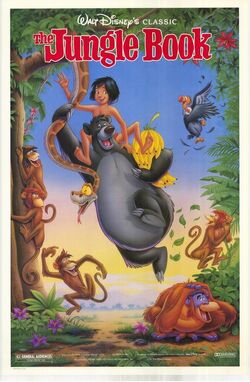
1990 Re-Release Poster
The Jungle Book was released in October 1967, just 10 months after Walt's death. It was a success, earning $13 million in just its domestic release, mostly due to the popularity of its musical numbers. The film was subsequently re-released in theaters in 1978, 1984, and 1990. The film made its VHS home video debut in Mexico on October 31, 1987, twenty years after its original release. This 1987 release was dubbed in Spanish. The Jungle Book was released in the United States on VHS in 1991 as part of the Walt Disney Classics product line. The American version was subsequently re-released in 1997 as part of the Walt Disney Masterpiece Collection for the film's 30th anniversary; this transfer had washed-out colors. A Limited Issue DVD was released by Buena Vista Home Entertainment in 1999. The DVD was barebones and used the 1997 VHS transfer with analog video. The film was released once again as a 2-disc Platinum Edition DVD on October 2, 2007 to commemorate its 40th anniversary. The Platinum Edition presents the film for the first time in 1.75:1 widescreen aspect ratio and also includes brand new luscious and rich colors. This is the first Disney release titled "Platinum Edition" in the UK instead of "Special Edition". The film was released on Blu-ray on February 11, 2014. On February 11 a petition was made to The Walt Disney Company to restore the original aspect ratio of the film to the Diamond Edition release. The other request the petition stated was to release the Blu-ray/DVD combo pack like its other Diamond Edition predecessors had before it. The petition has been proven affective by multiple people who feel the films current release was not up to par with other Disney releases.
Critical reaction
The Jungle Book received an outpouring of positive reviews upon release, undoubtedly influenced by a nostalgic reaction to the passing of Disney.[13] Time noted that the film strayed far from the Kipling stories, but "the result is thoroughly delightful...it is the happiest possible way to remember Walt Disney."[13] The New York Times called it "a perfectly dandy cartoon feature,"[24] and Life magazine referred to it as "the best thing of its kind since Dumbo, another short, bright, unscary and blessedly uncultivated cartoon."[35] Some negative reviews came from Judith Crist, who said the film was "devoid of mood or atmosphere." Variety's review was generally positive, but they stated that "the story development is restrained" and that younger audiences "may squirm at times."[13
Retrospective reviews were also positive, with the film's animation, characters and music receiving much praise throughout the years.[36] In 1990, when the film had its last theatrical re-release,Entertainment Weekly considered that The Jungle Book "isn't a classic Walt Disney film on the order of, say, Cinderella or Pinocchio, but it's one of Disney's liveliest and funniest",[37] while the Los Angeles Times thought the film's crew was "near the height of their talents" and the resulting film "remains a high-spirited romp that will delight children--and parents weary of action films with body counts that exceed their box-office grosses."[38] In 2010, Empire described the film as one that "gets pretty much everything right", regarding that the vibrant animation and catchy songs overcame the plot deficiencies.[39]
Awards
The song "The Bare Necessities" was nominated for Best Song at the 40th Academy Awards, losing to "Talk to the Animals" from Doctor Dolittle.[40] Academy of Motion Picture Arts and Sciences president Gregory Peck lobbied extensively for this film to be nominated for Best Picture, but was unsuccessful.[39] It was not until 1991 when Disney's Beauty and the Beast that an animated film would be nominated for Best Picture.
- American Film Institute Lists
- AFI's 100 Years...100 Movies - Nominated
- AFI's 100 Years...100 Songs:
- AFI's Greatest Movie Musicals - Nominated[42]
- AFI's 10 Top 10 - Nominated Animated Film[43]
Music
The score features eight original songs:
- "Jungle Book Overture" - (instrumental)
- "Colonel Hathi's March" - Colonel Hathi and the elephants
- "The Bare Necessities" - Baloo and Mowgli
- "I Wanna Be Like You" - King Louie and Baloo
- "Colonel Hathi's March (reprise)" - Colonel Hathi and the elephants
- "Trust in Me" - Kaa
- "That's What Friends Are For" - The Vultures, Mowgli and Shere Khan
- "My Own Home" - The Girl
- "The Bare Necessities (reprise)" - Baloo and Bagheera
Longtime Disney collaborator Terry Gilkyson was brought in to write the songs for the film. Gilkyson delivered several complete songs, but Walt Disney felt that his efforts were too dark. The Sherman Brothers were brought in to do a complete rewrite, on the condition that they not read Rudyard Kipling's book. The only piece of Gilkyson's work which survived to the final film was his upbeat tune "The Bare Necessities", which was liked by the rest of the film crew.
The song "Trust in Me" is based upon a song entitled "Land of Sand" which had been written by the Sherman Brothers for, but not used in, Mary Poppins. Part of "Bare Necessities" was remixed for the theme song of its short-lived 1990s TV spin-off, Jungle Cubs. In the scene where Bagheera, the vultures, and Mowgli believe that Baloo is dead as well as Bagheera funerals Baloo, Paul J. Smith's organ score from Walt Disney's first film Snow White and the Seven Dwarfs is heard from the scene where the seven Dwarfs mourn Snow White on her bed before she is put into the glass coffin.
"We're Your Friends" was originally conceived as a rock and roll song, sung by the quartet of vultures and an original character, Rocky the Rhino. The vultures were even designed based on The Beatles, with moptop haircuts and Liverpudlian accents, and would be voiced by the band, which did not come into fruition due to problems with their schedule. During production, first Rocky was cut, then Disney decided the 60's style rock would cause the song to be considered dated later, leading "We're Your Friends" to be changed to the barbershop quartet that appears in the final film. Bill Lee of The Mellomen sung Shere Kahn's part, due to George Sanders not being available.
On Classic Disney: 60 Years of Musical Magic, this includes "Colonel Hathi's March" on the red disc, "The Bare Necessities" on the blue disc, "I Wanna Be Like You" and "Trust in Me" on the green disc, "That's What Friends Are For" on the purple disc, and "My Own Home" on the orange disc.
The Disney's Greatest Hits collection includes the song "I Wanna Be Like You" on the blue disc and "The Bare Necessities" on the green disc.
Deleted songs
All of the below songs were the original songs by Terry Gilkyson.
- "Brothers All" – Opening
- "The Song of the Seeonee" – Wolf Pack
- "Monkey See, Monkey Do" – Monkeys
- "I Knew I Belonged to Her" – Mowgli
- "In A Day's Work" – Baloo and Bagheera
- "The Mighty Hunters" – Shere Khan and Buldeo the Hunter
Differences between the book and the film
When the Walt Disney Company read The Jungle Book, they decided to make it a more viewer friendly film and altered the story. Here are some main differences:
- Rama is simply Father Wolf in the book. His name in the film is an error; in the book, Rama is actually a bull from the cattle herd Mowgli had to drive when he lived in the man village.
- In the book, it is Father Wolf and Raksha who find Mowgli, not Bagheera as seen in the film.
- In the book, Bagheera spoiled Mowgli. He is more serious in the film.
- In the book, Shere Khan is killed by Mowgli and a herd of cattle. In the film, he does not die but runs away and tries to put out the flaming branch on his tail.
- In the film, Baloo is portrayed as a fun-loving, silly bear who cares deeply about Mowgli. In the book, he is a sleepy, serious bear who taught Mowgli the Law of the Jungle.
- In the book, Kaa is one of Mowgli's close friends who rescues Mowgli from the Bandar Log, and tells him of the golden ankus, and helps fight the red dogs. In the film, he is a minor antagonist who wants to eat Mowgli.
- In the film, Kaa hypnotizes with his eyes. In the book however, Kaa hypnotizes through a dance that affects everyone but Mowgli.
- In the book, Hathi is a wise ruler of the jungle, while in the movie he is a pompous war elephant who often forgets things.
- In the book, Hathi has three children, but no spouse. In the film, he has only one child, Junior, a wife, Winifred, and an equal amount of male and female herd members.
- In the film, the monkeys are ruled by a king, King Louie, while in the book they it is repeatedly stated that they have no form of leadership whatsoever. The monkeys are also much more sinister characters in the book, while in the film they are friendly to Mowgli and Baloo.
- The vultures are not present in the book either. They were original characters who were made to resemble The Beatles. The only bird that plays an important role in the book is Chil the Kite, who is absent from the film.
- Another character absent from the film is Tabaqui the Jackal. In the book, Shere Khan has a sidekick who is a mad cowardly jackal that scavenges the homes of others for scraps of food and such.
- The wolves play an important part in the book. In the film, the wolves are only in the beginning of the story.
- In the book, Mowgli eats meat like his foster wolf brother. In the film, he eats fruit like Baloo and King Louie.
- In the book, Mowgli realizes he needs to go back to the man village. In the film, he desires to stay in the jungle until the end of the film.
- There is no girl that lures Mowgli into the village in the book. In the book, the main female character is a woman named Messua who adopts Mowgli.
- In the Book Shere Khan is lame from birth, which is why he only killed cattle. In the film there is no mention of him being lame at all.
Legacy
Elements of The Jungle Book were recycled in the later Disney feature film Robin Hood due to that film's limited budget, such as Baloo being inspiration for Little John (who not only was a bear, but also voiced by Phil Harris). Many characters appear in the 1990-91 animated series TaleSpin. Between 1996 and 1998, the TV series Jungle Cubs told the stories of Baloo, Hahti, Bagheera, Louie, Kaa and Shere Khan when they were children.
Disney later made a live-action remake of the movie, which was more of a realistic action-adventure film with somewhat-more adult themes. The film, released in 1994, differs even more from the book than its animated counterpart, but was still a box-office success.
There are two videogames based on the film. The Jungle Book was a platformer released in 1993-4 for Master System, Mega Drive, Game Gear, Super NES, Game Boy and PC. A version for the Game Boy Advance was later released in 2003. The Jungle Book Groove Party was a dance mat game released in 2000 for PlayStation and PlayStation 2. Kaa and Shere Khan have also made cameo appearances in another Disney video game, Quackshot. There's some speculation that a world based on the film will be playable in the upcoming Kingdom Hearts Birth by Sleep video game for the PSP. This world was going to be in Kingdom Hearts but was dropped out due to similarities of a world known as Deep Jungle based on Tarzan. The events of that world could take place before the events of the film began.
On February 14, 2003, DisneyToon Studios in Australia released a sequel to the 1967 classic, entitled, The Jungle Book 2, in which Mowgli runs away from the man village he moved into at the end of the first film, to see his animal friends, unaware of the danger he's facing with the not-yet-dead Shere Khan who is more determined to kill him than ever, due to embarrassing him earlier. This film earned $47,901,582 at the box office. At Rotten Tomatoes, the film currently has a 4.4/10 rating and a 18% "Rotten" rating with 86 reviews, stating "This inferior rehash of The Jungle Book should have gone straight to video."
Since the movie's release, many of the film's characters appeared in House of Mouse, The Lion King 1½, Who Framed Roger Rabbit, and Aladdin and the King of Thieves.
Trivia
- In the game files for Kingdom Hearts Birth by Sleep, there exists locations for a world based on The Jungle Book. However, these locations are available for exploration via cheats.
- This is the first animated feature released after Walt Disney's death
- This is the first animated feature with the current MPAA logo. The film was rated G by the MPAA.
Gallery
External links
 The Jungle Book on Disney.com
The Jungle Book on Disney.com- Template:Imdb title
| v - e - d | ||||||||||||||
|---|---|---|---|---|---|---|---|---|---|---|---|---|---|---|
|
Template:Animated Feature-nav











